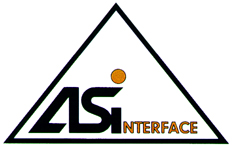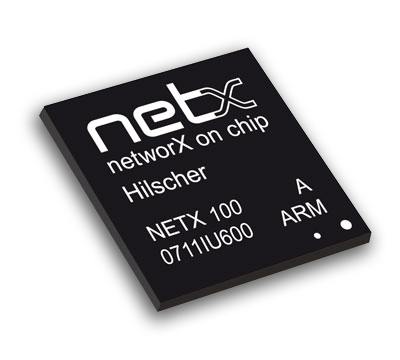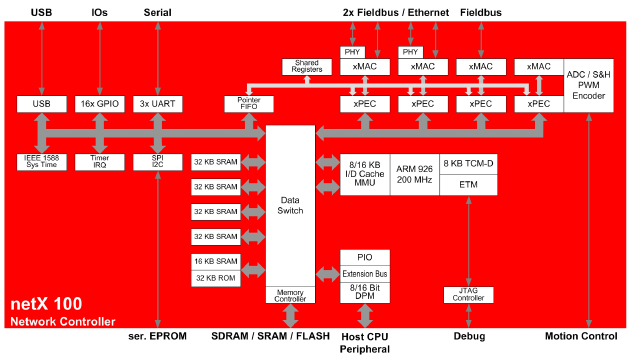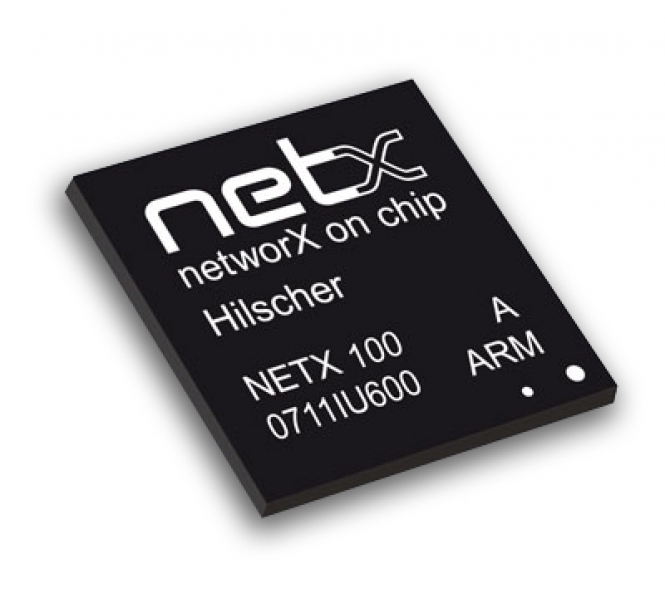© 2013 Uwe Wannags Hard-+ Software Distribution e.K (SWD)
HIL-NETX100
NETX 100


| netX 100 Network Controller The netX is a highly integrated network controller with a new system architecture optimized for communication and maximum data throughput. Based on the 32-Bit CPU ARM 926EJ-S cycled at 200 MHz, it possesses a memory management unit, caches, DSP and Java extensions. The internal memory of 144 KByte RAM and 32 KByte ROM that contains the Bootloader is sufficient for smaller applications whereas for Windows CE and Linux it is supplemented with the 32 Bit Memory Controller memory externally with SDRAM, SRAM or FLASH. The connection to a primary Host is carried out via the Dual-portmemory interface, which is configurable for stand-alone applications also as a 16 Bit extension bus. Comprehensive peripheral functions, serial interfaces such as UART, USB, SPI, I²C as well as the integrated graphic controller permit a wide spectrum of applications. Yet, it is the central data switch and the four freely configurable communication channels with their own intelligence that is the main characteristic of the netX as a "high end” network controller. The data switch connects via five data paths to the ARM CPU and the communication, graphic and Host controllers with the memory or the peripheral units. In this way the controllers transmit their data in parallel, contrary to the traditional sequential architecture with only one common data bus and additional bus allocation cycles. The controllers of the four communication channels are structured on two levels and are identical to each other. They consist of dedicated ALUs and special logic units that receive their protocol functions via Microcode. Two channels posses an additional integrated PHY for Ethernet. The Medium-Access-Controller xMAC sends or receives the data according to the respective bus access process and encrypts or converts these into Byte depictions. The Protocol Execution Controller xPEC compiles these into data packets and controls the telegram traffic. These are exchanged in DMA blocks over the memory of the ARM. In addition, every channel has a Dual-port-memory available for status information or as local data picture. With the intelligent communication ALUs, the netX carries out the most varied protocols and protocol combinations and can synchronize them independently of the reaction time of the CPU – an absolutely new feature in industrial communication technology. |
Facts at a glance:
|

| Product | NETX 100 | |
|---|---|---|
| Description | netX 100 Network Controller | |
| Computer Core | ||
| Processor | ARM 926EJ-S, 200 MIPS, ARMv5TE-command set with DSP- and Java-extension | |
| Cache | 16 KByte commands / 8 KByte Data | |
| Tightly Coupled Memory | 8 KByte Data | |
| Memory Managment Unit | Windows CE- and Linux-Support | |
| Internal memory | ||
| RAM | 144 KByte, of this 16 KByte with external voltage supply | |
| ROM | 32 KByte with Bootloader and Real-Time-Kernel | |
| Ethernet interface | ||
| Ports | 2 x 10BASE-T/100BASE-TX, Half-/Full-Duplex, IEEE 1588 time stamp | |
| PHY | Integrated, Auto-Negotiation, Auto-Crossover | |
| Real-Time-Ethernet | EtherCAT with three FMMUs and four Sync-Manager Ethernet/IP Powerlink with integrated Hub PROFINET RT with integrated Switch SERCOS-III Modbus IDA |
|
| Fieldbus-Interface | ||
| Channels | In case Ethernet isn't used two addictional fieldbus interfaces are available. Theses system can be combined arbitrarily. | |
| Systems | AS-Interface, Master only CANopen / DeviceNet PROFIBUS, Master and Slave CC-Link, Slave only |
|
| Peripherals | ||
| IEEE 1588 System Time | 32-bit second counter, 32-bit nanosecond counter | |
| USB | Revision 1.1, 12 MBaud Full-Speed, Host- or Device-Mode | |
| UART | 16550 compatible, max. 3 MBaud, RTS/CTS support Quantity 3 | |
| I²C | Master and Slave mode, 50 KHz up to 3.4 MHz, 16-bit FIFO, Quantity 2 | |
| SPI | Master- and Slave-Mode, max. 10 MHz, 3 Chip-Select-Signals | |
| AD-Converter | 2 x 4 Channels with 1MS/s Sample&Hold and 10 Bit-resolution Single ended, Common Analog Ground, external reference voltage | |
| PWM | 0–20 kHz/12 Bit-resolution 0–80 kHz/10 Bit-resolution | |
| Encoder | 2 Channels, Impuls quadruplication, digital input filter | |
| General I/Os | 3.3 V / 6 mA, Quantity 16 | |
| Status LEDs | 2 LEDs dual colored, 3.3 V/9 mA, Quantity 2 | |
| Memory-Interface | ||
| Memory bus | 32 Bit-Databus/24 Bit-Address bus | |
| Address region | 256 MByte SDRAM/64 MByte FLASH | |
| Memory modules | SDRAM, SRAM, FLASH | |
| Host-Interface | ||
| Dual-Port-Memory Mode | 8/16 Bit-Databus, 64 KByte configurable in 8 Blocks, emulated by internal RAM | |
| Extension-Mode | 8/16 Bit-Databus, 24 Bit-Address bus, Bustiming adjust table | |
| PIO-Mode | Freely programmable Inputs and Outputs | |
| Debug-Interface | ||
| JTAG | ARM-Processor and Boundary-Scan | |
| ETM | Embedded Trace Macrocell, ETM9 V2 Medium Size | |
| Operating Requirements / Housing / Miscellaneous | ||
| System cycles | 200 MHz ARM / 100 MHz Periphery | |
| Signal level | 3.3 V | |
| Power supply | 1.5 V for the core 3.3 V for Input/Output |
|
| Operating temperature | without heat sink –40..+70 °C with heat sink 10°/W –40..+85 °C |
|
| Storage temperature | -65°C..+150°C | |
| Power consumption | PHYs switched off typ. 1.0 W PHYs switched on typ. 1.5 W |
|
| Housing | PBGA, 1 mm raster, 345 Pins Dimensions 22 x 22 mm |
|
Copyright 2014 - Hilscher
Rev: 01/19
 Did you forget your password?
Did you forget your password?


